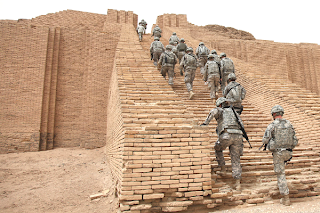The later Roman Empire always held this fascination, less for any sudden collapse, but more for the way in which it slowly meandered off to the side, to be replaced by yet another group of humans looking for their place in the world.
 |
| Mesopotamia |
This continual rise and fall was the product of an agrarian civilisation: agriculture led to surplus, which led to taxes to establish urban growth and organisation, which required a defensive system to protect this way of life from other aggressive city-states, under the control of the lugal, the priest-king, men with names like Gilgamesh, Lugalbanda the shepherd, Dumuzi the fisherman, and Lugalkidul.
This protection was made up of close-formation infantry, skirmishers and battle wagons. It was a system that would last for nearly four thousand years.
 |
| Unknown lugal from the Ur stelae |
 |
| Artist's representation of Ur |
 |
| Lagash - a romanticised view |
Back to the Sumerians.
 |
| Spearmen - Ur stelae |
These spears probably marched in formation, using bulk and weight of massed bodies to force an enemy to break, with the long spears adding killing power from the ranks. Later addition of shields may have shortened the spear to one-handed length, or a shield bearer may have been employed.
 |
| Later shielded spearmen |
And a special troop formation was the four onager battle cart, a cumbersome, probably bone-rattling four-wheeled platform, possibly used less as a killing machine than as a means of transport to the battlefield, or a high point for observing the fight. Even with four onagers dragging it across the rocky Sumerian landscape, it would have been relatively slow compared to later cavalry or chariotry, and the turning circle would have been a nightmare.
 |
| Sumerian lugal's helmet |
Battle cart - Ur stelae
 |
| Assembled forces of Sumerian lugal - by the great Angus McBride |
The Sumerian military system finally collapsed when it was confronted by stronger and more innovative attackers. The Akkadians, under Sargon I, and subsequent kings would eventually bring the Sumerian kingdoms under their control, only to lose them again with the rise of Third Dynasty of Ur, the kings of which used Akkadian mercenaries to bolster their forces. Sumer, however, would lose to the Babylonians, and would never again return to its former power.
 |
| 17th Fires Brigade, US Army, ziggurat of Ur, May 18th 2010 |
I met a traveller from an antique land
Who said: "Two vast and trunkless legs of stone
Stand in the desert. Near them on the sand,
Half sunk, a shattered visage lies, whose frown
And wrinkled lip and sneer of cold command
Tell that its sculptor well those passions read
Which yet survive, stamped on these lifeless things,
The hand that mocked them and the heart that fed.
And on the pedestal these words appear:
`My name is Ozymandias, King of Kings:
Look on my works, ye mighty, and despair!'
Nothing beside remains. Round the decay
Of that colossal wreck, boundless and bare,
The lone and level sands stretch far away".
- Percy Bysshe Shelley
A cautionary tale.
Hope you enjoyed
PC








That was neat, and the troops look great!
ReplyDeleteSimply outstanding PC
ReplyDeleteI am really liking the look of this
Along with the background information
great work Peter, especially like the chariot/cart.
ReplyDeletecheers
matt
A cautionary tale??? Does that mean we should 'ur' on the side if caution????
ReplyDeleteSomeone had to say it.
ReplyDeletePC
Sorry for being a pain in the onager. Cheers, Mark
ReplyDelete